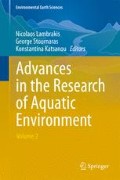Abstract
Drainage and lineament characteristics of a watershed provide important clues about the hydrogeology of the area. Information about the above characteristics derived from satellite imageries (IRS-IB) aided by field verifications and subsequently analyzed in Geographical Information System (GIS) environment can provide a composite map and which can be used for adopting a suitable strategy for managing watersheds in a better way particularly in relation to the augmentation of the status of groundwater by artificial recharge methods.
On the basis of the above concept, drainage, lineament and hydro geomorphic study of the upper catchment area of Kumari basin, Purulia, eastern India have been performed for demarcating prospective sites for construction of artificial recharge structures. Granitic lithology and uneven topography indicate that the surface run-off is high and infiltration is low and therefore groundwater recharge is inadequate in the area. So, mainly to keep the irrigation practice and drinking water supply alive, groundwater condition has to be improved by artificial recharge method. Integrating different types of thematic layers like drainage density, lineament density, hydro geomorphology in a GIS environment; it has been possible to generate a composite map showing prospective sites for construction of artificial recharge structures.
Access this chapter
Tax calculation will be finalised at checkout
Purchases are for personal use only
Preview
Unable to display preview. Download preview PDF.
References
Anbazhagan S, Ramaswamy S. M (2002) Remote sensing based artificial recharge studies - a case study from Precambrian terrain, India. In: Dillon, P. (eds) Management of Aquifer Recharge for Sustainability. Proc. of the 4th International Symposium of Artificial Recharge. AA Balkema Publishers: 553-556. Adelaide, Australia
Burrough (1990) PA Principles of GIS for Land Resource Assessment. Oxford science publication, Oxford.
Burroughs P P, McDonnel R A, Oxford university Press (1998) Principles of GIS. Oxford
Das D (1990) Satellite remote sensing in subsurface water targeting. In: Proc. of the ACSM-ASPRS Annual Convention, 99-103.Denver, USA
Karanth K R (1963) Scope of adopting artificial recharge in Babar Formation. In: Proc. of the symposium on groundwater. Geol. Survey of India, Miscellaneous Publication: 206-214. Calcutta, India
Kazemi R, Porchemmat J,Kheirkhah M(2009)Investigation of lineaments related to groundwater occurrence in a Karstic area: A case study in Lar catchment, Iran Res. J. of Environ. Sci. 3(3):367-375, ISSN1819-3412
Kumanan C J (2009) Remote sensing revealed morphotectonic anomalies as a tool to neotectonic mapping-experience south India. http://www.crisp.nus.edu.s/~acrs2001/pdf/195kumanan.pdf
Saraf A K, Choudhury P R, Sarma B, Ghosh P (2001) Impacts of reservoirs in groundwater and vegetation: A study based on Remote Sensing and GIS techniques. Int. J. of Remote Sens. Vol 22, No. 13 pp 2439-2448
Sharma, K. D. (2002), Rainwater management in India: Some policy issues. In: Subrahmanyam K (eds) Proc. of the workshop on the Water Crisis - Hope and Action for humanity's future. Hyderabad, India, National Geophysical Research Institute pp 1-8
Strahler, A. N. (1952), Dynamic basis of Geomorphology, Bull. Geol. Soc. America Vol 63 pp 923-938
Veerana, M. (2002), Artificial Recharge Methods of groundwater in hard-rock formations and case studies. In: Subrahmanyam K (eds) Proc. of the Workshop on the Water Crisis - Hope and Action for humanity's future. Hyderabad, India, National Geophysical Research Institute pp 117-125
Author information
Authors and Affiliations
Editor information
Editors and Affiliations
Rights and permissions
Copyright information
© 2011 Springer-Verlag Berlin Heidelberg
About this chapter
Cite this chapter
Das, D. (2011). Drainage and lineament analysis towards artificial recharge of groundwater. In: Lambrakis, N., Stournaras, G., Katsanou, K. (eds) Advances in the Research of Aquatic Environment. Environmental Earth Sciences. Springer, Berlin, Heidelberg. https://doi.org/10.1007/978-3-642-24076-8_5
Download citation
DOI: https://doi.org/10.1007/978-3-642-24076-8_5
Publisher Name: Springer, Berlin, Heidelberg
Print ISBN: 978-3-642-24075-1
Online ISBN: 978-3-642-24076-8
eBook Packages: Earth and Environmental ScienceEarth and Environmental Science (R0)

